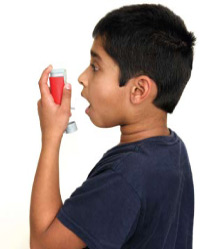Have you heard of someone complaining about their asthma? Or perhaps seen a person breathing in using an inhaler. Although asthma is not uncommon, it still remains one of the mysteries of modern medicine. It has no single cause and does not have a cure up till today. Children are prone to developing asthma if a family member has it, as it is hereditary among families – every child has a 6% chance of developing asthma, which increases to 30% if one parent is asthmatic and 70% if both parents have it.
In general, asthma is a condition whereby the airways to the lungs are temporarily narrowed or blocked, resulting in symptoms such as coughing, wheezing, shortness of breath and chest tightness. Patients suffering from asthma often describe the attacks as breathing through a straw in your mouth while pinching your nose closed!
Does your child have asthma?
Seeing your child suddenly gasping for breath is a scary experience for parents, especially since children are more prone to asthma attacks because their airways are narrower than those of adults. All asthma attacks require immediate attention and medical treatment, but parents can learn to recognise early warning signs of an attack, such as:
- Coughing. Sometimes, coughing can be the only symptom to an asthma attack. If your child is coughing frequently, especially at night and with no illness to cause it, it may be a sign of an asthma attack coming on. Furthermore, if your child has been having a persistent cough for 2 weeks or more, without any apparent reason, then it is highly probable that he may be suffering from asthma.
- Breathing. If your child is having a hard time breathing, listen closely to him, as this may be a sign of an oncoming asthma attack. Listen for any wheezing, loud and fast breathing and watch if he breathes with his nostrils flared, or if he tries to clear his throat often. A child who has asthma also often has a wheezing sound even when breathing normally.
- Be observant. Check if your child shows other physical symptoms such as vomiting, sweating and pale skin, as these are signs of a possible asthma attack. Your child may also complain of feeling tight or uncomfortable in his chest.
Triggering asthma
Asthma is most often inherited from a family member, however children can also develop asthma from exposure to environmental factors, which is known as allergic asthma. Triggers that lead to asthma attacks vary in different individuals and it is important that you know what causes the asthma in your child.
Be careful of these…
Some of the more common indoor environmental irritants that may trigger an asthma attack include:
- Pet fur, feathers, dander, pet urine or saliva.
- House dust mites.
- Mould and spores.
- Cockroach droppings, dead cockroaches.
- Tobacco smoke.
- Perfumes, hairsprays, scented lotions.
- Cleaning solutions, pesticides, paint fumes.
In some children, their asthma symptoms become worse when they breathe in irritants like cigarette smoke, polluted air or odours, paint fumes and aerosol sprays. These substances can easily irritate the upper airways and lower airways causing children to wheeze, cough, and have runny nose or watery eyes. Asthma can also sometimes be triggered by the climate; exposure to cold or even very hot air, can cause an asthma attack in your child.
Avoid those nasty irritants!
The best thing to do for children who have asthma is to try to avoid the triggers that cause them. But sometimes, these triggers – like cats, colds or pollen – can’t be avoided and that’s when medication is needed to manage the asthma. In children with mild intermittent symptoms which is day time symptoms less than a week and nocturnal symptoms less than twice a month and well in between episodes does not require long term medication. He uses asthma medication only when their asthma flares-up. This is known as rescue or reliever medicine (Bronchodilators such as short acting beta agonists (SABA) and anticholinergics) because it works rapidly to open up the airways for the child to breathe.
In children who are symptomatic with daytime symptoms more than once a week and night symptoms more than twice a month and having asthma exacerbations affecting sleep and activity more than once a month will need longterm treatment, which is a preventive medication in the form of inhaled corticosteroids. These medications need to be taken daily to suppress inflammation and prevent flaresup from occurring. If they remain symptomatic despite on inhaled corticosteroids provided the child is compliant to the inhaler, a controller medication will be added in the form of long-acting B2 agonist or anti-leukotrienes. However it is important that these children who are on long term therapy to be follow- up by a doctor regularly to assess his symptoms and asthma control as well to adjust the medication dose regularly.
Asthma medication is most often dispensed through an inhaler, which is held up to the mouth and pressed to release a mist into the lungs when breathed in. Children are not encouraged to use inhaler by using this technique, as this require coordination. Children need a vent with a facemask or mouthpiece. This medication relaxes the airways, making it easier for the child to breathe. Inhalation therapy is a muchpreferred route of medication compared with oral medicine, as inhaled medicine is directly delivered to the lungs with little, or no side effects.
Prevention is the key
Medication does play an important role in managing asthma; however, the best way to control asthma is still through prevention. Here are some things in which you could do to help keep your child’s environment free from potential asthma irritants.
- Always keep your house free from dust or pet fur by vacuuming the carpets and mats around the house. Discourage dust mites – clean the bed sheets and curtains regularly, soaking them in hot water first before washing. Try to keep certain rooms pet-free and make sure that your pets are bathed often to reduce the occurrence of dander.
- If weather or air pollutants triggers asthma, you may need to limit your child to playing indoors when the weather is bad or if the air is especially polluted.
- Don’t allow smoking in the house at all costs! Smoking is bad for the lungs even for normal persons, and can especially aggravate the symptoms in those suffering from asthma. Keep your child away from smokers in and outside the house.
Having a child who suffers from asthma isn’t easy for the whole family. However, life can be almost normal with proper precautions and management. Many children grow out of asthma as they grow older, or have less severe attacks. Doctors believe that as a child gets older, his airways widen and make it easier for the air to get in and out, thus reducing the frequency of getting asthma attacks. In the mean time, treat asthma seriously and always make sure that your child’s medications are on hand. Uncontrolled asthma can lead to more severe attacks, which may result in death if not given proper emergency treatment immediately.






Comments